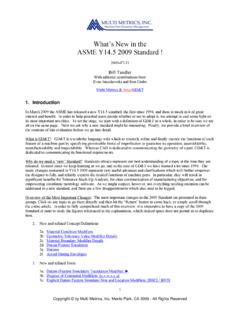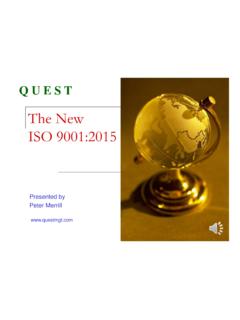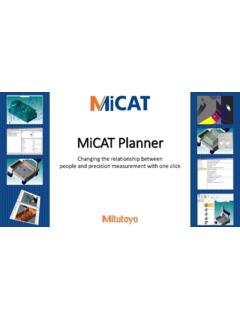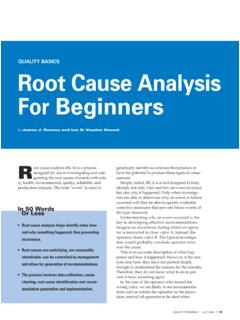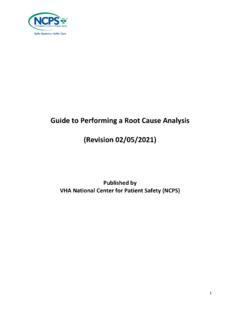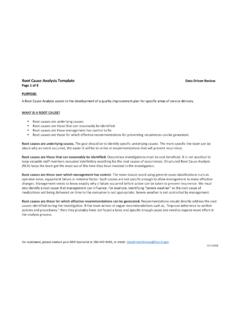Transcription of Root Cause Analysis Tools and Techniques - Quality Digest
1 T V S D T V S D CAPA Essentials root Cause Analysis Tools and TechniquesPresented by Edna R. Falkenberg21/10/2014 Slide 1T V S DT V S D T V S D in numbers: Growing from strength to strength21/10/2014 Slide 21 One-stop technical solution provider800locations worldwide employees worldwide 20,200million Euro in sales revenue 20131,900150years of experienceT V S DGlobal expertise. Local experience. Global Headquarters: Munich, GermanyINTERNATIONALEuro 750 mio9,800 staffGERMANYEuro 1,190 mio10,400 staffLegend: Countries with T V S D officesRegional headquartersNote: Figures have been rounded off. 14-05-12 Slide 3T V S DT V S D America Inc.
2 T V S D America Inc., founded in 1987, is the North American subsidiary of T V S D AG. T V S D America Inc. provides complete services through its divisions: Product Service Management Service Industry Service Chemical, Oil and Gas Global Risk ConsultantsT V S DDefining the root Cause is at the heart of problem solving. This is often the most difficult and challenging phase. If the root Cause were apparent then the problem would have been addressed earlier! root Cause AnalysisT V S D There are usually three causes to be considered during a problem solving effort: Occurrence, Escape and Systemic. The occurrence root Cause the specific local Cause that resulted in the problem.
3 This is typically the factor that changed in the process. The escape root Cause the Cause that resulted in the problem not being caught or detected. The systemic root Cause the broader Cause responsible for the local Cause to be present in the first place. This Cause is often procedural in nature. Long term corrective Cause AnalysisT V S DTo start: Review the problem definition (5W2H) and Is/Is-Not looking for potential occurrence causes . Ask What Changed ? Review the process flow for clues to potential root Cause AnalysisT V S DPurpose Answer the question: What s wrong with what? Define a problem statement that includes both an object and a defect.
4 Development of a dynamic problem statement that will be the foundation for the : Problem DescriptionT V S DPurpose A problem well defined is a problem half solved. A complex problem can not be solved or addressed until it is completely understood and Develop a well-thought out problem description and the resultant problem or deviation statement. Describe the problem in terms of its effects on the downstream customer (internal or external). tool : Problem DescriptionT V S DThe problem description covers a broad range of criteria: Who is experiencing the problem? What is the problem? Where and when did it occur?
5 When? Why is this a problem? What is the downstream effect? How big is the problem? (How much? How many?)These components are consolidated into the abbreviation: 5W s and 2H s. tool : Problem DescriptionT V S DWho? Identify the customers (internal or external) that are experiencing the problem or registering the complaint. Which groups are impacted by the effect of the problem?What? Classify the problem in terms of an object and the defect. Determine the part or object in question. Where? Where (geographically) was the defect found? Which plant? Which state/region/country? Which customer location? If there is a defective part: Where is the defect located?
6 On the part? In the assembly? technique : A concentration ( measles ) chart may be very helpful. tool : 5 W s and 2 H sT V S DDefinition: A measles chart is a simple map that Provides a visual representation of failure data. Shows frequency and location of errors. Uses a schematic drawing of the : Measles Chart T V S D The problems or errors may be of diverse types. Unique shapes and color codes can represent different failure modes. Different markings also represent degree of severity. The chart does not need to be very detailed. Keep it simple so that there are no problems with : Measles Chart T V S DWhen?
7 Analyze control charts, run charts and/or shipment records to determine exactly when the problem began. Ask whether the problem occurs on all shipments or only specific shifts or days of production? Is the issue seasonal? Has this problem previously occurred during the same time of year? Or has the problem been present since the start of production? An examination of the qualification documentation may reveal some : 5 W s and 2 H sT V S DWhy? Identify the effect of the failure. There may be more than one! Will help focus containment and identify : 5 W s and 2 H sT V S DHow much? How many? Determine the magnitude of the problem.
8 How much nonconforming material was sent to the customer? How many parts were defective? What was the defect count? What is the percent defective? Compare the magnitude of the problem to prior baseline defect rates. Did something change in our process or has the problem been present from the start of production? tool : 5 W s and 2 H sT V S D These comparative Techniques help cut the phonebook in half . For example: If someone selected a random name in the phone book and asked you to figure out the name through a series of questions -- what question might you ask first? You may want to ask whether the first letter begins with the letters A through K.
9 This cuts the number of potential names roughly in half! tool : Is/Is Not A powerful companion tool involves the usage of Techniques developed by the consulting firm of Kepner and Tregoe (formerly of the RAND corporation).T V S D The Is/Is Not is the most common tool in comparative Analysis . Is/Is Not is based on examination of the 5W s and 2H s and asking paired questions: tool : Is/Is Not What is happening? What could be happening but is NOT. T V S DExample: (Q1) Who is experiencing the problem? (A1) The customers in Europe. (Q2) Who could be experiencing the problem but is not? (A2) The customers in Asia Get Information and clear-up any missing : Is/Is Not T V S DDescription of the ProblemISIS NOTGet Information OnCommentsWho (What Customer)What (Object) name the object that is having trouble (Defect) name the trouble or problem that the object is havingWhere ( Seen on the object) Where on the object is the problem occurring (inside, outside, top, bottom etc)?
10 Where in the process flow did the problem first develop?Describe all other places with regards to where the object and the trouble can be found (Seen Ge ographi cal ly) Name the place where the object with the trouble can be found. Name the place where it first showed up. Name all placed where the problem has (First Seen) When, with respect to the time, did the trouble/problem first occur? day, month, year, time of day, etc. Describe any patterns in when in the process the trouble first in the life cycle did the trouble first occur? (When else seen) Describe other places in process and life cycle when the trouble or problem was observed.


